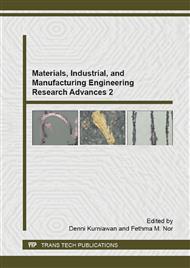[1]
Mohanty AK., Misra M., Hinrichsen G., Biofibres biodegradable polymers and biocomposites: An overview, Macromol Mater Eng. 276/277 (2000) 1–24.
DOI: 10.1002/(sici)1439-2054(20000301)276:1<1::aid-mame1>3.0.co;2-w
Google Scholar
[2]
Mohanty AK., Drzal LT., Misra M., Novel hybrid coupling agent as an adhesion promoter in natural fiber reinforced powder polypropylene composites, J Mater Sci Lett. 21 (2002)1885–1888.
Google Scholar
[3]
Misri S., Leman Z., Sapuan S., and Ishak M., Mechanical properties and fabrication of small boat using woven glass/sugar palm fibres reinforced unsaturated polyester hybrid composite, IOP Conference Series: Materials Science and Engineering. 11 (2010).
DOI: 10.1088/1757-899x/11/1/012015
Google Scholar
[4]
Foulk JD., Akin DE., Dodd RB., New low cost flax fibers for composites. SAE 2000 World Congress. (2000) 6–9.
DOI: 10.4271/2000-01-1133
Google Scholar
[5]
Xia M., Takayanagi H., and Kemmochi K., Analysis of multi-layered filament-wound composite pipes under internal pressure, Composite Structures. 53 (2001) 483-491.
DOI: 10.1016/s0263-8223(01)00061-7
Google Scholar
[6]
Xia M., Kemmochi K., and Takayanagi H., Analysis of filament-wound fiber-reinforced sandwich pipe under combined internal pressure and thermomechanical loading, Composite structures. 51(2001) 273-283.
DOI: 10.1016/s0263-8223(00)00137-9
Google Scholar
[7]
Rosenow M. W. K., Wind angle effects in glass fibre-reinforced polyester filament wound pipes, Composites. 15(1984), 144-152.
DOI: 10.1016/0010-4361(84)90727-4
Google Scholar
[8]
Shultz, M., and Smith, L. V., Optimal fiber orientation for fiber reinforced pressure vessels, Applied Mechanics. (2004) 7-10.
Google Scholar
[9]
Highton, J., Adeoye, A. B., and Soden, P. D., Fracture stresses for±75 degree filament wound grp tubes under biaxial loads, The Journal of Strain Analysis for Engineering Design. 20 (1985) 139-150.
DOI: 10.1243/03093247v203139
Google Scholar
[10]
Eckold, G. C., D. Leadbetter, Lamination theory in the prediction of failure envelopes for filament wound materials subjected to biaxial loading, Composites. 9 (1978) 243-246.
DOI: 10.1016/0010-4361(78)90176-3
Google Scholar
[11]
Carswell, W. S., An atlas of polymer damage: Lothar Engel, Herman Klingele, Gottfried W. Ehrenstein and Helmut Schaper (Eds. ), Wolfe Science Books, International Journal of Fatigue 3 (1981) 218.
DOI: 10.1016/0142-1123(81)90027-x
Google Scholar
[12]
Spencer, B. and D. Hull, Effect of winding angle on the failure of filament wound pipe. Composites, 9 (1978) 263-271.
DOI: 10.1016/0010-4361(78)90180-5
Google Scholar
[13]
Bakaiyan H., Hosseini H., and Ameri E., Analysis of multi-layered filament-wound composite pipes under combined internal pressure and thermomechanical loading with thermal variations, Composite Structures. 88 (2009) 532–541.
DOI: 10.1016/j.compstruct.2008.05.017
Google Scholar
[14]
Kunel S., A short review on Basalt fiber, International Journal of Textile Science. 1 (2012) 19-28.
Google Scholar
[15]
ASTM D2584-11, Standard Test Method for Ignition Loss of Cured Reinforced Resins, ASTM International, West Conshohocken, PA, (2011), www. astm. org.
Google Scholar
[16]
ASTM D2105-01, Standard Test Method for Longitudinal Tensile Properties of Fiberglass, (Glass-Fiber-Reinforced Thermosetting-Resin) Pipe and Tube, ASTM International, West Conshohocken, PA, (2014), www. astm. org.
DOI: 10.1520/d2105
Google Scholar
[17]
ASTM D2290-00, Standard Test Method for Apparent Hoop Tensile Strength of Plastic or Reinforced Plastic Pipe by Split Disk Method, ASTM International, West Conshohocken, PA, (2000), www. astm. org.
DOI: 10.1520/d2290-00e01
Google Scholar
[18]
ASTM D1599-14, Standard Test Method for Resistance to Short-Time Hydraulic Pressure of Plastic Pipe, Tubing, and Fittings, ASTM International, West Conshohocken, PA, (2014), www. astm. org.
DOI: 10.1520/d1599-99r11
Google Scholar
[19]
Jones, M.L.C. and D. Hull, Microscopy of failure mechanisms in filament-wound pipe, Journal of Materials Science. 14 (1979) 165-174.
DOI: 10.1007/bf01028340
Google Scholar
[20]
Almula, T. A. D. M. S., S. Sharifi, et al., Static Analysis of Stitched Sandwich Beams with Functionally Graded Foam Core, Applied Mechanics and Materials. 393 (2013) 381-386.
DOI: 10.4028/www.scientific.net/amm.393.381
Google Scholar
[21]
Almula, T. A. D. M. S., M. Y. Yahya, et al., Mechanical Behavior of Functionally Graded Sandwich Hollow Cylinders under Internal Pressure, Advanced Materials Research 845 (2014) 360-366.
DOI: 10.4028/www.scientific.net/amr.845.360
Google Scholar


